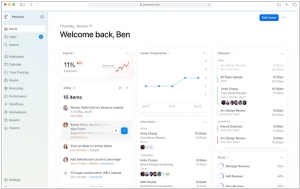Forcepoint vs Microsoft Purview
October 11, 2024 | Author: Michael Stromann
19★
Complete security for all cloud applications. Use leading machine learning and UEBA capabilities to establish behavioral fingerprints for advanced risk calculation.
13★
Govern, protect, and manage all of your data with Microsoft Purview, comprehensive solutions to help give you better visibility and control.
In the vast, bewildering cosmos of data management, two peculiar entities float through the ether: Forcepoint and Microsoft Purview. Forcepoint is the sort of system that would rather you didn’t even try to sneak out with the last doughnut, let alone classified information. It’s built to watch everything with the steely gaze of a cybernetic hawk, preventing data breaches and snuffing out insider threats with the subtlety of a brick. Web security, data loss prevention—Forcepoint handles it all with the grim determination of a sentient firewall that just won’t take a day off.
Meanwhile, Microsoft Purview is a different breed entirely. Picture a fastidious, data-obsessed archivist, cataloging and tracking everything with a cosmic clipboard in hand. It’s less about stopping things from happening and more about *knowing* everything that has ever happened, mapping data lineage with the precision of a star chart. It helps organizations discover where their data lives, what it’s doing and whether it’s playing by the rules, all while radiating a calm assurance that it’s seen it all before.
While Forcepoint stands at the gates like a cybernetic bouncer, ensuring no rogue data escapes, Microsoft Purview is quietly rearranging the shelves in the library of the data universe, making sure everything is in order. Both useful in their own ways, each keeps the chaos of the digital galaxy at bay, one by brute force, the other by sheer organization.
See also: Top 10 DLP software
Meanwhile, Microsoft Purview is a different breed entirely. Picture a fastidious, data-obsessed archivist, cataloging and tracking everything with a cosmic clipboard in hand. It’s less about stopping things from happening and more about *knowing* everything that has ever happened, mapping data lineage with the precision of a star chart. It helps organizations discover where their data lives, what it’s doing and whether it’s playing by the rules, all while radiating a calm assurance that it’s seen it all before.
While Forcepoint stands at the gates like a cybernetic bouncer, ensuring no rogue data escapes, Microsoft Purview is quietly rearranging the shelves in the library of the data universe, making sure everything is in order. Both useful in their own ways, each keeps the chaos of the digital galaxy at bay, one by brute force, the other by sheer organization.
See also: Top 10 DLP software




